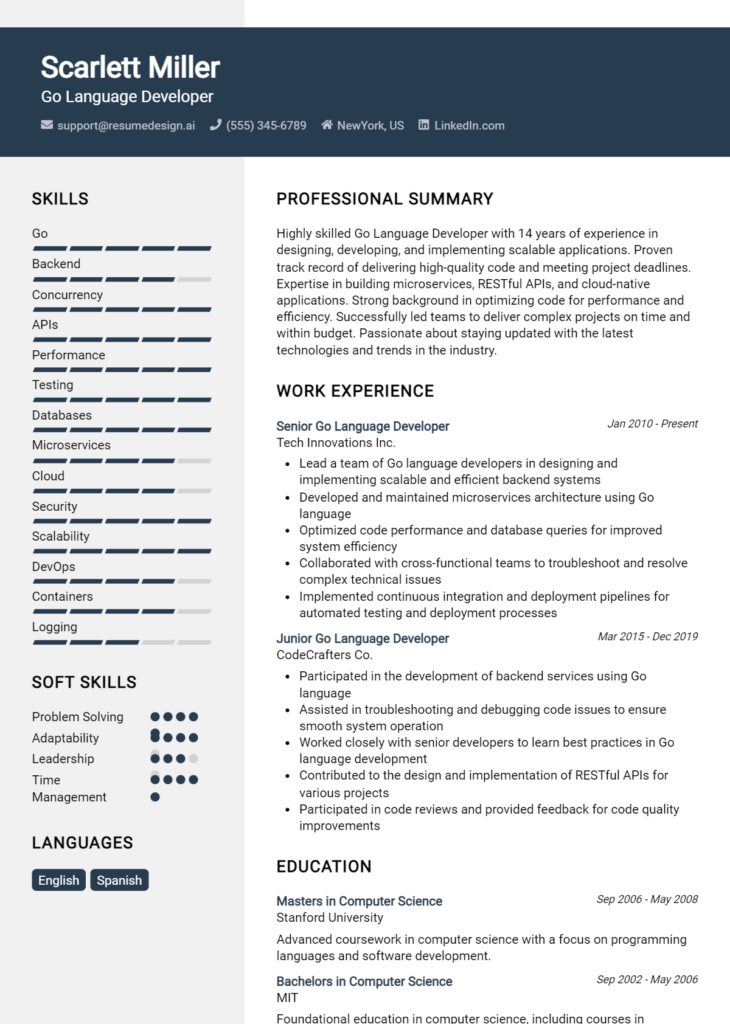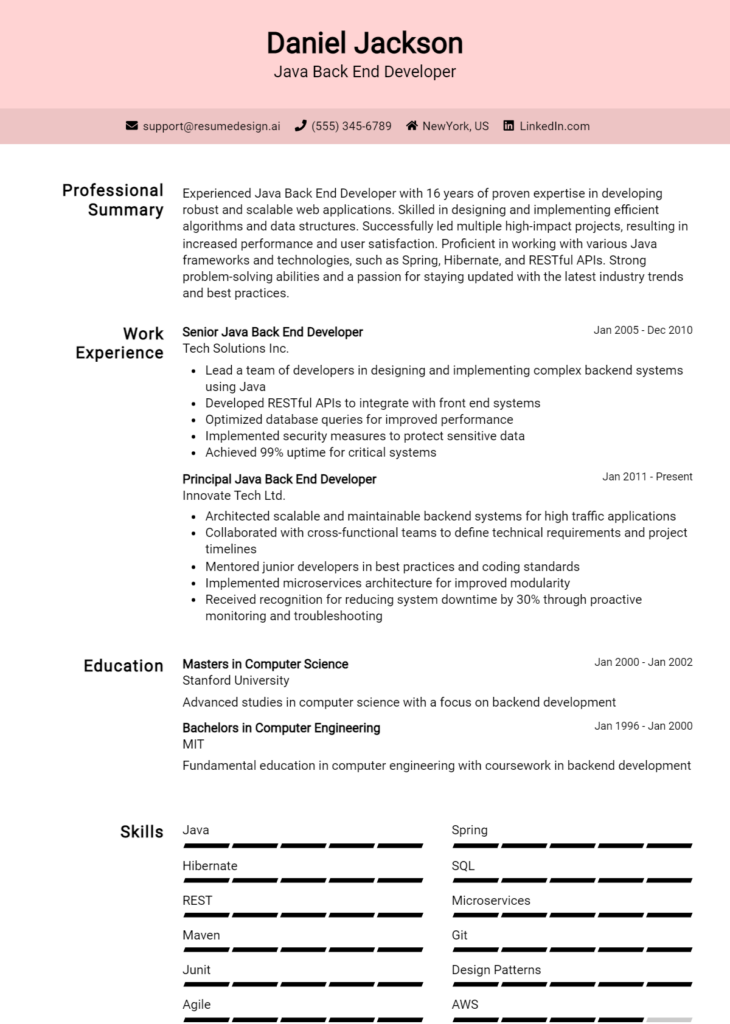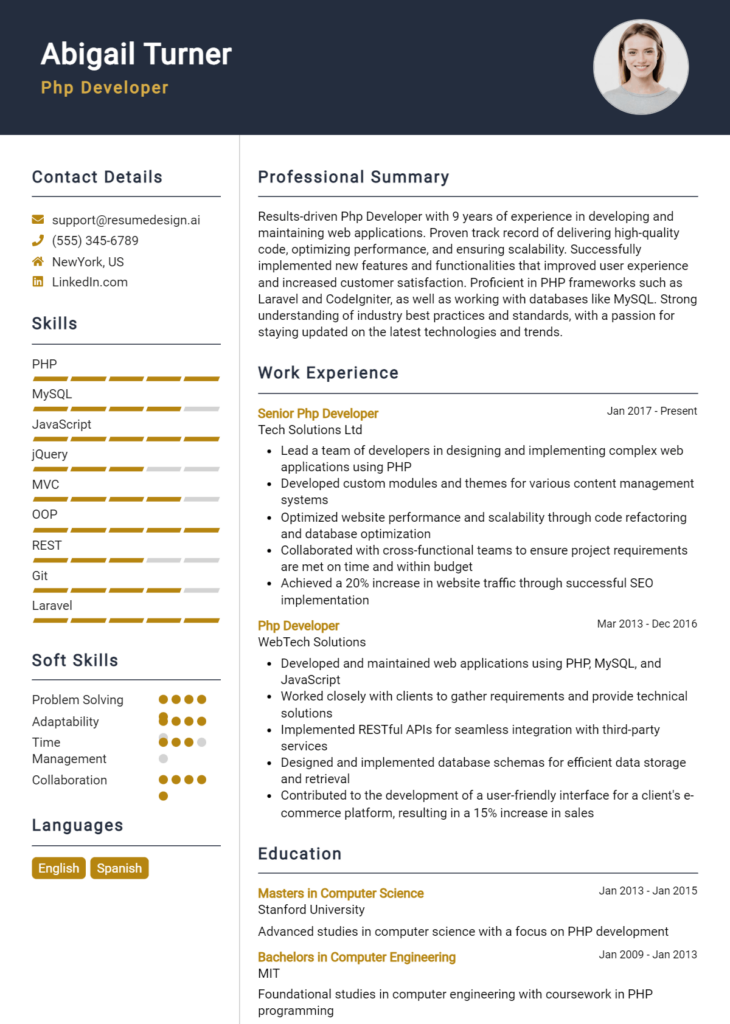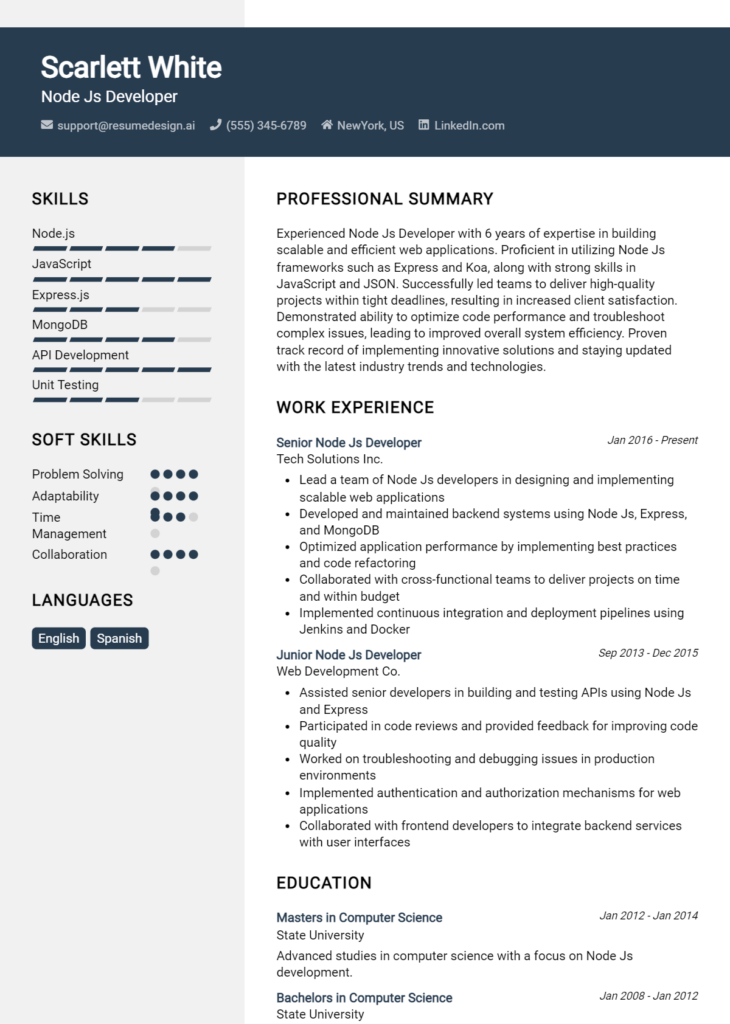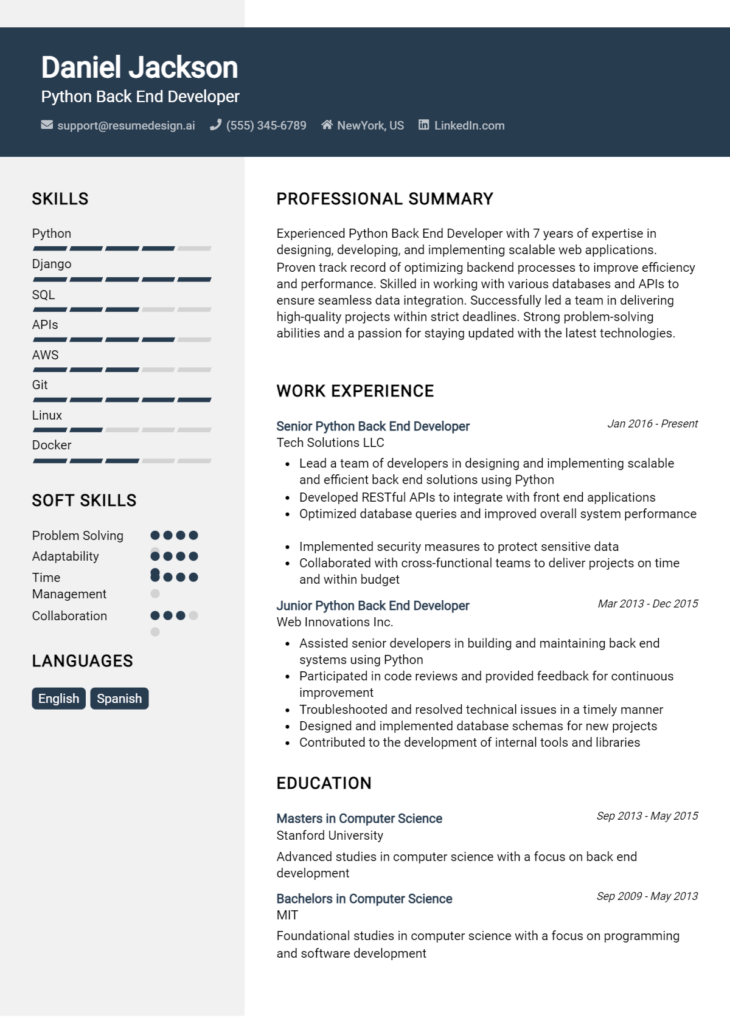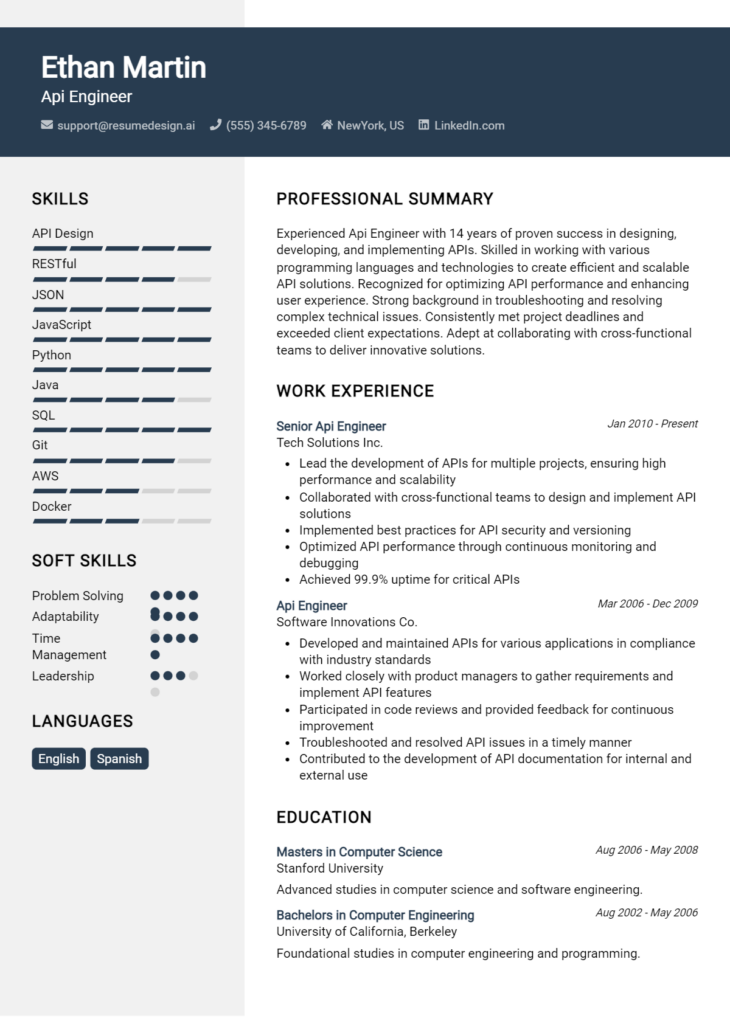Server-Side Developer Core Responsibilities
A Server-Side Developer plays a crucial role in creating and maintaining the backend of applications, ensuring seamless data processing and communication between various departments. Key responsibilities include designing APIs, managing databases, and optimizing server performance, requiring strong technical skills in languages like Java, Python, or Node.js. Additionally, problem-solving abilities are essential for troubleshooting issues effectively. A well-structured resume highlighting these competencies not only showcases technical and operational expertise but also demonstrates the developer's contribution to the organization's overarching goals.
Common Responsibilities Listed on Server-Side Developer Resume
- Develop and maintain server-side logic and databases.
- Create and manage APIs for client-side integration.
- Optimize applications for maximum speed and scalability.
- Collaborate with front-end developers to integrate user-facing elements.
- Implement security measures and data protection strategies.
- Perform troubleshooting and debugging of applications.
- Write clean, maintainable, and efficient code.
- Document development processes and application architecture.
- Monitor server performance and conduct regular system audits.
- Stay updated with emerging technologies and industry trends.
- Participate in code reviews and provide constructive feedback.
- Collaborate with cross-functional teams to align project goals.
High-Level Resume Tips for Server-Side Developer Professionals
In the competitive landscape of technology careers, a well-crafted resume is essential for Server-Side Developer professionals. It serves as the first impression a candidate makes on a potential employer, and it must effectively showcase both technical skills and notable achievements. A resume that is thoughtfully constructed can differentiate you from a sea of applicants and highlight your capabilities in a way that resonates with hiring managers. In this guide, we will provide practical and actionable resume tips specifically tailored for Server-Side Developer professionals to help you stand out in your job search.
Top Resume Tips for Server-Side Developer Professionals
- Tailor your resume to each job description by incorporating keywords and phrases that match the requirements of the position.
- Showcase relevant experience by prioritizing projects that demonstrate your server-side programming skills, such as proficiency in languages like Java, Python, or Node.js.
- Quantify your achievements with concrete metrics, such as the percentage increase in system efficiency or the reduction in load times resulting from your contributions.
- Highlight industry-specific skills such as API development, database management, and knowledge of cloud services like AWS or Azure.
- Include a section for technical skills that categorizes your proficiencies, such as programming languages, frameworks, and tools you are familiar with.
- Utilize a clean and professional layout to ensure that your resume is easy to read and visually appealing, making it easier for employers to find key information quickly.
- Incorporate links to your GitHub repositories or personal projects to provide tangible evidence of your coding abilities and project experience.
- Write a compelling summary that encapsulates your experience, skills, and what you bring to a potential employer, making sure it aligns with the job you’re applying for.
- Keep your resume concise, ideally to one page, while ensuring that it effectively communicates all necessary information without overwhelming the reader.
By implementing these tips, you can significantly increase your chances of landing a job in the Server-Side Developer field. A targeted and well-organized resume will not only highlight your technical expertise but also demonstrate your commitment to the role, making you a more attractive candidate to potential employers.
Why Resume Headlines & Titles are Important for Server-Side Developer
In the competitive field of server-side development, a well-crafted resume headline or title serves as a crucial first impression for hiring managers. This brief statement can effectively summarize a candidate's key qualifications, drawing attention and prompting further review of the resume. A strong headline should be concise, relevant, and tailored to the specific job being applied for, encapsulating the most pertinent aspects of the candidate's skills and experiences. By doing so, it sets the tone for the rest of the resume, positioning the candidate as a strong contender from the outset.
Best Practices for Crafting Resume Headlines for Server-Side Developer
- Keep it concise: Aim for a headline that is no longer than a single sentence.
- Be specific: Use terms that relate directly to server-side development, such as "Java Expert" or "Node.js Developer."
- Highlight key skills: Incorporate critical technical skills or programming languages relevant to the position.
- Include years of experience: If applicable, mention how many years of experience you have in the field.
- Use action-oriented language: Start with strong verbs or descriptors that imply achievement and capability.
- Tailor for each application: Customize the headline to align with the job description and company culture.
- Avoid jargon: Use clear and straightforward language that any hiring manager can understand.
- Make it impactful: Choose words that convey confidence and competence.
Example Resume Headlines for Server-Side Developer
Strong Resume Headlines
"Senior Server-Side Developer with 7+ Years in Java and Microservices Architecture"
"Experienced Node.js Developer Specializing in Scalable Web Applications"
“Full-Stack Developer with Strong Server-Side Expertise in Python and Django”
“Results-Driven Server-Side Engineer with Proven Track Record in API Development”
Weak Resume Headlines
“Developer with Experience”
“IT Professional Seeking Opportunities”
Strong resume headlines are effective because they provide clear, specific, and relevant information that immediately captures the hiring manager's attention. They convey a sense of professionalism and expertise, showing that the candidate understands the requirements of the role. In contrast, weak headlines often lack detail and specificity, leaving hiring managers with little insight into the candidate's qualifications or value. This can result in the application being overlooked in favor of those who present themselves more compellingly.
Writing an Exceptional Server-Side Developer Resume Summary
A well-crafted resume summary is essential for a Server-Side Developer as it serves as the first impression to hiring managers. A strong summary quickly captures attention by highlighting key skills, relevant experience, and significant accomplishments that align with the job role. With hiring managers often sifting through numerous applications, a concise and impactful summary can set a candidate apart, increasing their chances of being shortlisted for an interview. Tailoring the summary to the specific job description further ensures that it resonates with the employer's needs, making it a critical component of the resume.
Best Practices for Writing a Server-Side Developer Resume Summary
- Quantify Achievements: Use numbers and percentages to highlight specific accomplishments.
- Focus on Relevant Skills: Emphasize technical skills and programming languages that are pertinent to the position.
- Be Concise: Keep the summary brief, ideally between 2-4 sentences.
- Tailor for the Job: Customize the summary to reflect the requirements and keywords from the job description.
- Showcase Problem-Solving: Mention any successful projects or solutions implemented that demonstrate critical thinking and innovation.
- Highlight Team Collaboration: If applicable, note experience working in teams or cross-functional environments.
- Include Industry Keywords: Use terminology that is relevant to the tech industry to enhance visibility in applicant tracking systems.
- Create a Compelling Narrative: Write in a way that tells a story about your career journey and passion for server-side development.
Example Server-Side Developer Resume Summaries
Strong Resume Summaries
Results-oriented Server-Side Developer with over 5 years of experience in designing and implementing scalable web applications. Achieved a 30% reduction in server response time through optimized database queries and effective caching strategies.
Detail-oriented software engineer skilled in Python and Node.js, with a proven track record of delivering high-quality code on time. Successfully migrated legacy systems to cloud-based solutions, resulting in a 25% increase in deployment efficiency.
Innovative Server-Side Developer with expertise in RESTful APIs and microservices architecture. Led a team project that improved system reliability by 40%, enhancing user satisfaction and reducing downtime.
Weak Resume Summaries
Experienced developer looking for a position in server-side programming.
Skilled in various programming languages and technologies, seeking opportunities to apply my knowledge.
The examples considered strong effectively showcase specific achievements, relevant skills, and quantifiable outcomes that directly relate to the role of a Server-Side Developer. They provide a clear picture of the candidate's capabilities and demonstrated successes. In contrast, the weak summaries lack detail and specificity, making them generic and unmemorable. They fail to communicate the candidate's unique value or any measurable impact, which is critical in a competitive job market.
Work Experience Section for Server-Side Developer Resume
The work experience section of a Server-Side Developer resume is crucial as it provides a comprehensive overview of the candidate's technical capabilities and past contributions to the field. This section not only highlights the specific programming languages, frameworks, and tools the candidate has mastered but also demonstrates their ability to manage teams and collaborate effectively on projects. By quantifying achievements—such as improvements in system performance or successful project deployments—and aligning experience with industry standards, candidates can effectively convey their value to potential employers.
Best Practices for Server-Side Developer Work Experience
- Highlight relevant technologies and frameworks used in each experience.
- Quantify achievements with specific metrics (e.g., improved load times by 30%).
- Emphasize collaboration by detailing team roles and cross-functional efforts.
- Use action verbs to convey impact and initiative (e.g., developed, optimized, led).
- Tailor experiences to match the job description and industry requirements.
- Include notable projects that showcase problem-solving skills and innovation.
- Focus on results-driven statements that reflect contributions to the organization’s success.
- Keep descriptions concise while providing enough detail to demonstrate expertise.
Example Work Experiences for Server-Side Developer
Strong Experiences
- Led a team of 5 developers to implement a microservices architecture, resulting in a 40% increase in application scalability and a 50% reduction in downtime.
- Engineered a RESTful API that processed over 1 million transactions per month, enhancing data retrieval speed by 70% and improving user satisfaction ratings by 25%.
- Collaborated with cross-functional teams to design and deploy a cloud-based solution, reducing operational costs by 20% and improving deployment times by 35%.
Weak Experiences
- Worked on several projects involving server-side development tasks.
- Participated in team meetings to discuss project progress and issues.
- Involved in the development of applications and contributed to coding efforts.
The strong experiences demonstrate impactful contributions through quantifiable outcomes, such as improved performance metrics and cost reductions, while also showcasing technical leadership and collaboration. In contrast, the weak experiences lack specificity and measurable results, making them less compelling to potential employers. Strong examples effectively illustrate how a candidate has made a significant difference in their role, while weak examples fail to provide a clear picture of the candidate's abilities and achievements.
Education and Certifications Section for Server-Side Developer Resume
The Education and Certifications section of a Server-Side Developer resume plays a crucial role in demonstrating a candidate's foundational knowledge and commitment to professional growth. This section not only showcases the academic achievements that form the basis of a developer's skill set but also highlights industry-relevant certifications that validate their expertise in specific technologies and methodologies. By detailing relevant coursework, certifications, and specialized training programs, candidates can significantly enhance their credibility and alignment with the job requirements, making a compelling case for their qualifications in the competitive field of server-side development.
Best Practices for Server-Side Developer Education and Certifications
- Emphasize relevant degrees in Computer Science, Software Engineering, or related fields.
- Include industry-recognized certifications such as AWS Certified Developer or Microsoft Certified: Azure Developer Associate.
- List relevant coursework that pertains specifically to server-side technologies, databases, or programming languages.
- Highlight any advanced degrees or specialized training that showcases expertise in server-side development.
- Ensure all entries are up-to-date and reflect recent advancements in technology.
- Consider including online courses or bootcamp completions that enhance your skill set.
- Use clear and concise language to describe your education and certifications.
- Tailor the section to align closely with the job description to attract the attention of hiring managers.
Example Education and Certifications for Server-Side Developer
Strong Examples
- Bachelor of Science in Computer Science, University of Technology, 2020
- AWS Certified Solutions Architect, 2021
- Full Stack Web Development Bootcamp, Coding Academy, 2022
- Relevant Coursework: Advanced Database Management, Web Services and APIs, and Cloud Computing.
Weak Examples
- Diploma in Graphic Design, Community College, 2019
- Certification in Basic Photography Techniques, 2018
- High School Diploma, Anytown High School, 2016
- Old Course: Introduction to JavaScript, 2015 (not relevant anymore)
The strong examples are considered effective because they directly relate to the skills and knowledge required for a Server-Side Developer position, showcasing relevant degrees, certifications, and advanced training. In contrast, the weak examples lack relevance to the field of server-side development and do not demonstrate an adequate understanding or experience in the required technologies, thereby failing to support the candidate's qualifications for the role.
Top Skills & Keywords for Server-Side Developer Resume
When crafting a resume for a Server-Side Developer position, showcasing the right skills is crucial to standing out in a competitive job market. Employers seek candidates who possess both technical and interpersonal abilities that enable them to effectively contribute to their teams and projects. Highlighting these skills not only demonstrates your qualifications but also your understanding of the demands of the role. A well-structured resume that emphasizes both hard and soft skills can significantly enhance your chances of securing an interview and ultimately landing the job.
Top Hard & Soft Skills for Server-Side Developer
Soft Skills
- Problem-solving
- Communication
- Team collaboration
- Adaptability
- Time management
- Attention to detail
- Critical thinking
- Creativity
- Conflict resolution
- Empathy
Hard Skills
- Proficiency in server-side programming languages (e.g., Java, Python, Ruby)
- Database management (SQL, NoSQL)
- API development and integration
- Understanding of server architecture
- Familiarity with cloud services (AWS, Azure, Google Cloud)
- Knowledge of version control systems (e.g., Git)
- Experience with containerization tools (Docker, Kubernetes)
- Strong debugging and testing skills
- Familiarity with web frameworks (e.g., Node.js, Django)
- Performance optimization techniques
By integrating both skills and work experience into your resume, you can create a comprehensive profile that reflects your capabilities as a Server-Side Developer.
Stand Out with a Winning Server-Side Developer Cover Letter
Dear [Hiring Manager's Name],
I am writing to express my interest in the Server-Side Developer position at [Company Name] as advertised on [where you found the job listing]. With a strong background in backend development and a passion for crafting efficient and scalable server-side solutions, I believe I am well-equipped to contribute effectively to your team. My experience with technologies such as Node.js, Java, and SQL, combined with my knowledge of RESTful APIs and microservices architecture, has prepared me to tackle the challenges of this role head-on.
In my previous position at [Previous Company Name], I successfully designed and implemented various server-side applications that improved data processing efficiency by over 30%. Collaborating closely with front-end developers and cross-functional teams, I ensured seamless integration of user-facing elements with server-side logic. My commitment to writing clean, maintainable code and performing thorough testing has consistently resulted in high-quality deliverables that meet project deadlines. Furthermore, I am experienced in utilizing cloud services like AWS and Azure for deploying applications, which aligns well with [Company Name]'s technological goals.
I am particularly drawn to [Company Name] because of your commitment to innovation and excellence in [specific project or value the company holds]. I am eager to bring my expertise in server-side development and my proactive approach to problem-solving to your talented team. I am confident that my technical skills, combined with my enthusiasm for continuous learning and improvement, will allow me to make a meaningful impact on your projects and contribute to the overall success of the organization.
Thank you for considering my application. I look forward to the opportunity to discuss how my background, skills, and enthusiasms align with the needs of your team. I am excited about the possibility of contributing to [Company Name] and am eager to share my ideas on how we can achieve great things together.
Sincerely,
[Your Name]
[Your LinkedIn Profile or Website]
[Your Contact Information]
Common Mistakes to Avoid in a Server-Side Developer Resume
When crafting a resume for a Server-Side Developer position, it's crucial to avoid common pitfalls that can hinder your chances of landing an interview. A well-structured and relevant resume can highlight your technical skills and experience, but mistakes can detract from your qualifications. Here are some common mistakes to steer clear of to ensure your resume stands out for the right reasons:
Lack of Specificity: Failing to specify programming languages, frameworks, or technologies can leave recruiters guessing about your expertise. Make sure to list your skills clearly and concisely.
Overcomplicating Technical Jargon: While it’s important to demonstrate your technical knowledge, using excessive jargon or complex terminology can alienate non-technical hiring managers. Keep your language accessible.
Ignoring the Job Description: Not tailoring your resume to align with the specific job requirements can result in your application being overlooked. Always customize your resume for each position to highlight the most relevant experience.
Neglecting Soft Skills: Focusing solely on technical skills and neglecting soft skills like teamwork, communication, and problem-solving can lead to an incomplete picture of your capabilities. Include examples of how you've applied these skills in your work.
Using an Unorganized Format: A cluttered or confusing layout can make it difficult for recruiters to find the information they need. Use clear headings, bullet points, and consistent formatting for better readability.
Listing Responsibilities Instead of Achievements: Simply outlining job duties doesn’t showcase your impact. Focus on your achievements and how you contributed to projects or improved processes.
Failing to Include Relevant Projects: Omitting personal or open-source projects can minimize your practical experience. Highlight any relevant projects that demonstrate your skills and initiative.
Inaccurate or Outdated Information: Providing incorrect dates or outdated technologies can raise red flags for employers. Make sure all information is current and accurately reflects your experience and skills.
Conclusion
As a Server-Side Developer, you play a crucial role in building the backbone of web applications, ensuring seamless communication between the front end and back end. In this article, we discussed the essential skills required for this role, including proficiency in server-side languages such as Node.js, Python, and Ruby, as well as familiarity with databases, APIs, and various frameworks. Additionally, we highlighted the importance of understanding security protocols, optimization techniques, and cloud services to enhance your development process.
We also touched on the significance of collaboration with other teams, such as front-end developers and UX/UI designers, to create cohesive and efficient applications. Continuous learning and staying updated with the latest industry trends are vital for your growth and success as a Server-Side Developer.
As you reflect on your career and aspirations, it's an excellent time to review your Server-Side Developer resume. Make sure it showcases your skills, experiences, and achievements effectively. To assist you in this process, consider utilizing tools like resume templates, resume builder, resume examples, and cover letter templates. These resources can help you create a standout resume that captures the attention of potential employers. Take action today and enhance your professional presentation!


